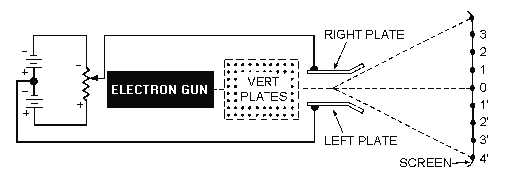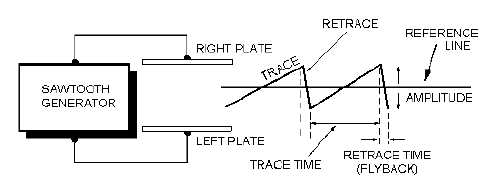6-9
Figure 6-11.—Horizontal plates (top view).
If the potentiometer arm is moved at the same rate in the opposite direction, the right plate will
decrease in positive potential until the beam returns to the 0 position. At that point, the potential
difference between the plates is again zero. Moving the arm toward the other end of the resistance causes
the left plate to become more positive than the right, and the beam moves from screen points 0 through 4.
If the movement of the potentiometer arm is at a uniform (linear) rate, the beam moves at a uniform rate.
Notice that the ends of the deflection plates are bent outward to permit wide-angle deflection of the
beam. The vertical plates are bent up and down in the same manner.
Q-12. Why are the ends of the deflection plates bent outward?
For ease of explanation, the manual movement of the potentiometer arm is satisfactory to introduce
you to horizontal beam movement. However, in the oscilloscope this is not how horizontal deflection is
accomplished. Beam movement voltages are produced much faster by sawtooth circuitry. You may want
to review the sawtooth generation section in NEETS, Module 9, Introduction to Wave-Generation and
Wave-Shaping Circuitry before continuing. Nearly all oscilloscopes with electrostatic deflection apply a
sawtooth voltage to the horizontal plates to produce horizontal deflection of the beam, as shown in
figure 6-12.
Figure 6-12.—Sawtooth generator.
In the figure, the sawtooth generator replaces the potentiometer and is connected to both horizontal
plates of the CRT. At the reference line, the potential on both plates is equal. Below the line, the left plate
is more positive and the right plate is less positive. This causes the beam to move left. Above the line, the
right plate is made more positive than the left and the beam moves to the right. The waveform amplitude
causes a uniform movement of the beam across the screen (called TRACE). RETRACE time, shown at
the trailing edge of the waveform, quickly deflects the beam back to the starting point.



